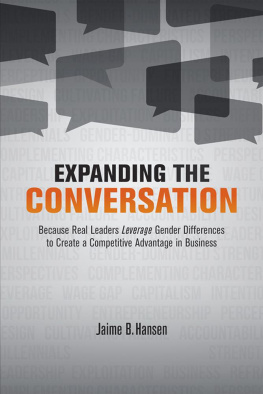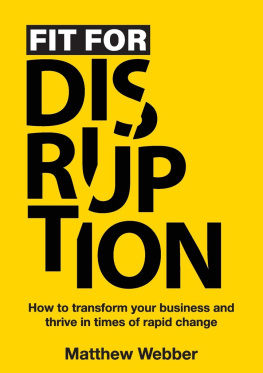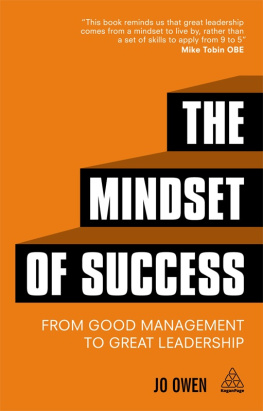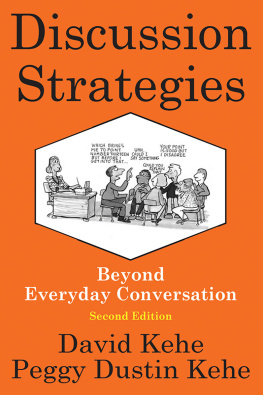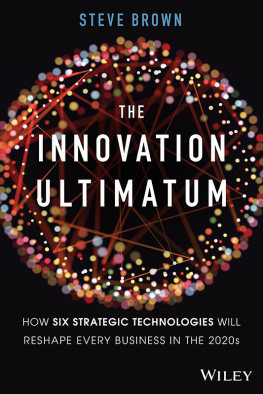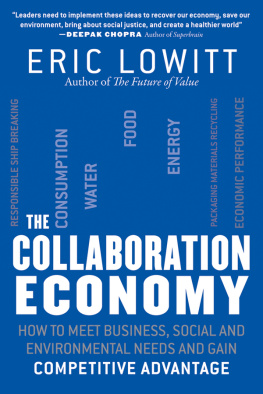EXPANDING THE
CONVERSATION
Because Real Leaders Leverage Gender Differences
to Create a Competitive Advantage in Business
Jaime B. Hansen
Copyright 2017 by Jaime B. Hansen.
Library of Congress Control Number: | 2017901165 |
ISBN: | Hardcover | 978-1-5245-7849-7 |
Softcover | 978-1-5245-7847-3 |
eBook | 978-1-5245-7848-0 |
All rights reserved. No part of this book may be reproduced or transmitted in any form or by any means, electronic or mechanical, including photocopying, recording, or by any information storage and retrieval system, without permission in writing from the copyright owner.
Any people depicted in stock imagery provided by Thinkstock are models, and such images are being used for illustrative purposes only.
Certain stock imagery Thinkstock.
Rev. date: 04/10/2017
Xlibris
1-888-795-4274
www.Xlibris.com
756200
Contents
There is no conversation more boring
than the one where everybody ag rees.
MICHEL DE MONTAIGNE
I have known Jaime for a very long time. In fact, our relationship goes back to the beginning of her business career. And for a very long time, I have been conflicted, sometimes thinking of her as an unapologetic idealist, and sometimes thinking of her as a dogged pragmatist. She has proven, through this book, that she is both, and probably always was. Because of her and its balance (and insights), the book should make tremendous strides to expanding and improving the conversation about gender in the business p lace.
Jaime sketches for us a much-improved business world, one that harnesses the skills of women. That improved world is one that understands that there are differences between the genders in the business place. And though equal, women should not try to be the same as men. It is also a world that accepts that there are differences in the genders. Soft skills, which are often deemed to be female strengths, and hard skills, which are often deemed to be male strengths, are equally valuable in the workplace. Further, Jaimes new world is one that celebrates gender differences. Women are often quite advanced in the ways they interact, communicate, and build trust. Those skills should be encouraged, and spread. She tells us to take advantage of each of our unique characteristics. We must. And her world is one that accentuates gender qualities that we all possess. We are all capable of diving deep and laser focus (perhaps a male quality). We are all capable of thinking holistically and comprehensively about relationships and situations (perhaps a female quality). There is no need, according to Jaime, to allow and foster thinking that relegates a certain set of skills to a certain gender. Right brain and left brain need to be equally advanced, in both gen ders.
After reading her book, I am convinced that we can and should strive for this better business world. We owe it to up-and-coming leaders, particularly women. Their diverse talents need to flourish, and so will their careers. We owe it to stodgy and grumpy leaders (whose club arguably includes me), who need to tap into a richer set of skills. And we owe it to companies whose competitive positioning is at stake, which is every company, every day.
Jaime not only sketches for us a better business world; she provides suggestions for filling in the picture. She suggests use of improved rhetoric. Women, she notes, are often perceived as emotional or sensitive. Wouldnt it be better to refer to such characteristics as empathetic or compassionate? Or instead of creative, how about innovative? She suggests elimination of confusing and distracting facts. It is often quoted that women are paid 79 cents for every $1 made by a male. While not dismissing the significance of the point, she has cautioned us to understand and use that statistic, and many like it, with great care. She suggests eliminating discussion of fairness and equality. Business is not about those concepts. And she suggests that leaders and soon-to-be leaders, men and women, all need to participate in the conversation and ultimate change. Leaders can re-frame the conversation. Soon-to-be leaders must insert themselves into that conversation, and along the way, not add to implicit biases. Jaime sensibly makes the case that words, actions, and thoughts are all implic ated.
Throughout her book, Jaime does a masterful job of presenting and discussing a wide range of evidence. Sometimes its anecdotes. Sometimes its academic studies. Sometimes its reports in the popular press. Sometimes its interviews. Sometimes its biology. Jaime flies high, but has a very strong foundation for doing that. Not surprisingly, she writes that her husband (with whom I go back as far as Jaime), doesnt like to call himself a feminist. Of course, he knows he is one. Jaime sees things that the rest of us do not, in part, because she is looking so clo sely.
One of Jaimes important themes is that the genders are equal, but not the same. She asks us to accentuate the equality, and de-emphasize the need to be the same.
I am extraordinarily proud to write that I was there at the launch of Jaimes career in economics. I knew (as did others) that she was going to make a difference. This book proves that. Leveraging her impressive formal training, her rich experience in business, and her frequent writing and speaking work, she will help us all to expand our conversations about gender differences. Those conversations will allow many of us to enhance our careers, our work, and our competitive advant ages.
John C. Jarosz
Managing Principal, Analysis Group
In the last few years, weve seen a monumental upswing in the discussions around women in business. Thats fantastic. In general, the more attention this topic receives the better. My concern is with the direction these conversations have taken as of late. Driven largely by the headline-seeking media, much of the current talk focuses on the extreme and the provocative. Its as if the goal now is solely to maximize shock v alue.
In contrast, the purpose of this book is to expand the conversation. There are many worthwhile topics on this subject deserving further discussion, but so much of the present dialogue is angry and accusatory and dangerously one-sided. Because of this, these conversations have become largely ineffective. That fact will be highlighted throughout Expanding the Conversation ; however, the goal is not simply to recognize it. Its to start talking about ways to actually change th ings.
Although it addresses issues around women in business, this book is not solely directed at women. It is also for men who work with women. The business world is not properly leveraging a big portion of our countrys eligible workforce. Thats not a female problem; its a very big and very real labor chall enge.
All the angry and bitter talk about things not being fair and equal in business thats not helpful to anyone. Why? Well lets just be real about this from the get-go. Business isnt fair, and it never will be. That may seem harsh, but its the sobering reality. We need to both acknowledge and, to some degree, accept this if we intend to move forward. Demanding we treat women the same as men in business because thats only fair sounds almost amateur. Furthermore, for those more seasoned, it often comes off as defen sive.
Most important, its falling on deaf ears. We cant possibly expect to solve problems if they arent being openly considered and addressed from all angles. We have to be able to put everything on the tableall of itand look at the issues from multiple viewpoints. Thats how we get to the bottom of real is sues.
It begins with a basic acknowledgement: Men and women are not the same. Equal, of course, but not for a minute the same. Much of the advice offered lately has been around hiding these differences or ignoring themsometimes adamantly insisting they dont even exist. Thats a huge mistake. The differences between men and women are what make things all the more interesting, especially in a business environment. Individuals have varied strengths and weaknesses. Confronting these differences head on will allow us to better leverage themeven, dare I suggest, exploit them. After all, in the end, business is really just one big game of stra tegy.
Next page
